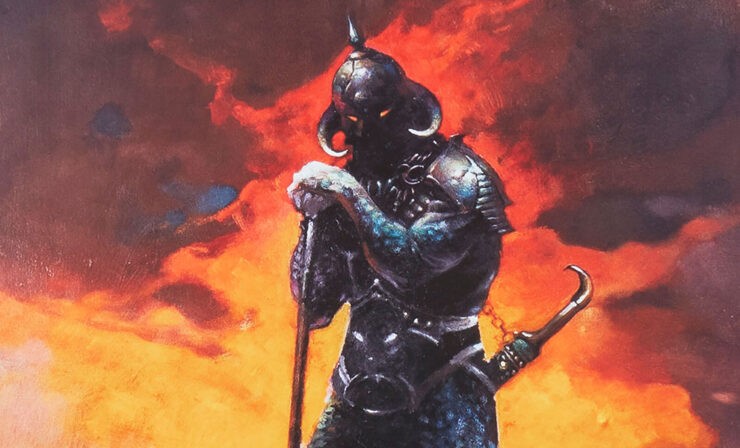
The Most Iconic Frank Frazetta Fantasy Artwork
Often called the “godfather of fantasy art,” Frank Frazetta (1928 — 2010) is one of the most renowned artists of the 20th century. His epic ink and pencil drawings, oil paintings, and watercolor illustrations have defined the aesthetics and look of fantasy and science fiction genre works for decades. Creators such as Guillermo del Toro (Crimson Peak, Hellboy) George Lucas (Star Wars™), George R.R. Martin (Game of Thrones) and many more have been endlessly inspired by Frazetta’s lavish designs.
Frazetta is accredited with redefining fantasy art itself. Not only did he illustrate epic characters and scenes, but he imbued layers of narrative into every painting. More than simply capturing a moment, he added a new story to whatever media — music, novel, magazine, movie — in which his art was found.
Among his most famous portfolio pieces are film posters, album covers, comic panels, and book covers. And while his work is extensive, with over one hundred paintings to his name, some are effortless stand outs. They’ve lived on as legends in their own right along with Frazetta’s astounding legacy. Explore these genre-defining covers and paintings below.
The Barbarian
Frank Frazetta’s The Barbarian (1966) originally appeared on the cover of Robert E. Howard’s fantasy short story collection. At the time, Frazetta was painting for mass market paperback editions of popular books, and took on this commission without ever having read Howard’s series. Coincidentally, The Barbarian is widely considered one of the most influential fantasy works ever produced. The Barbarian cemented Howard’s protagonist’s physical representation for every adaption to come. It also inspired other fantasy writers and artists to replicate Frank Frazetta’s style, color palette, and posing in their own speculative fiction art.
Egyptian Queen
The Egyptian Queen debuted on the cover of Eerie magazine #23 in 1969. Eerie was an American comic that published black and white horror comics for newsstand distribution alongside its sister publications Creepy and Vampirella. Such an evocative artwork has ensorcelled audiences for years, and it’s not difficult to see why. Simmering with both seduction and danger, the Egyptian Queen must have been an alluring cover to grace Eerie‘s glossy pages. So alluring, in fact, that the original painting was recently sold for a world record $5.4 million at Heritage Auctions.
Death Dealer I and Death Dealer III
The menacing, iron-clad warrior depicted in Death Dealer I (1973) is undoubtedly one of Frazetta’s most recognizable images. After its publication, the painting led to spin-off merchandise including other artistic renders, novels, statues, two comic series, and related Dungeons & Dragons adventures. Most notably, Death Dealer I was utilized by southern rock band Molly Hatchet’s debut album in 1978. Immortalized in pop culture, the Death Dealer’s imposing presence can be found in various visual mediums worldwide.
After the success of Death Dealer I, Frank Frazetta went on to paint covers for the novel franchise by James Silke. Book 2, Lords of Destruction (1989), features Death Dealer III. Although the warrior has dismounted from his monstrous steed, he is no less terrifying as plumes of smoke and vibrant flames billow behind him. Bones flow through rivers of blood at his feet, promising death to all those who oppose him. From the visual cues alone, we are able to ascertain so much about this character as well as his history, and that is just one small part of Frazetta’s brilliance.
Red Planet
Red Planet is a Frazetta original painting created for Lin Carter’s Time War (1974). Carter was known for drawing inspiration from fantasy, sci-fi, mythology, and fairy tales. These interests blend beautifully with Frazetta’s imagination in Red Planet. It depicts the intrepid, time-traveling hero and his beautiful companion as they face beings intent on destroying the world. The perspective of this original painting allows the viewer to feel like they are watching the action unfold from behind the two subjects. This participatory gaze is quite common in Frazetta’s work.
Dracula and Beyond the Grave
Frazetta’s take on the eternal Dracula first graced the cover of Warren Publishing’s Creepy #5 (1966). Audiences were so horrified and fascinated by this creature that the same image returned for the collector edition issue Creepy #144 (1983). This dark yet stunningly colorful piece gives the audience every detail they need to form their opinion of the Count and his dark deeds, clearly cementing it as one of the most celebrated depictions of a fan-favorite Universal Monster.
Finally, Frazetta took on Frankenstein’s monster in Beyond the Grave. Published on the cover of Creepy #10 (1966), this haunting horror artwork is imbued with all the complicated emotions surrounding this troubled, tragic figure. Frank Frazetta’s signature rich color tones, sweeping scenery, and storytelling abilities are all showcased in this iconic image that breathes new life into Mary Shelley’s undying wretch.
What is your favorite Frank Frazetta artwork? Let us know in the comments, and don’t forget to Let Your Geek Sideshow!






